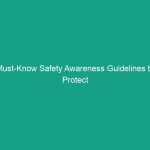Introduction
In the realm of Health, Safety, and Environment (HSE), the Prevention of backovers and struck-by incidents is a critical concern for businesses across various industries. These incidents, often resulting from the Operation of vehicles and heavy machinery in workplaces, can lead to severe injuries or fatalities. Understanding the importance of stringent Safety protocols and practices is paramount in creating a safe working environment. By focusing on the prevention of backovers and struck-by incidents, organizations can not only comply with regulatory frameworks but also foster a culture of Safety that protects their employees and assets.
Regulatory Frameworks
To effectively address the prevention of backovers and struck-by incidents, it is essential to be familiar with the regulatory frameworks that govern Workplace Safety. Various organizations, including the Occupational Safety and Health Administration (OSHA) in the United States, have established guidelines aimed at minimizing risks associated with heavy machinery and vehicle operations.
osha Regulations
OSHA has implemented specific regulations that require employers to provide a safe working environment. For instance, OSHA’s Standard 1910.178 pertains to the operation of powered industrial trucks and mandates that employers train operators in Safe Driving Practices. These regulations not only highlight the need for proper Training but also stress the importance of providing adequate Safety Measures like mirrors and alarms in vehicles to mitigate the risks of backovers.
Environmental Protection Agency (EPA) Guidelines
The Environmental Protection Agency also plays a role in ensuring that machinery operations do not harm the environment or public health. By following EPA guidelines, companies can ensure that their operations are compliant with environmental Standards, which indirectly supports the prevention of backovers and struck-by incidents by promoting safer operational practices.
Best Practices for Prevention
Implementing Best Practices is crucial for the prevention of backovers and struck-by incidents in the workplace. These practices encompass a wide array of strategies, from training and awareness to the utilization of safety technology.
Comprehensive Training Programs
One of the most effective ways to prevent backovers is through comprehensive training programs for all employees, particularly those operating vehicles and heavy machinery. Training should cover the following key areas:
- Understanding blind spots and their impact on visibility.
- Proper use of mirrors and cameras to enhance visibility.
- Safe maneuvering techniques in crowded or tight spaces.
Regular refresher courses can also help maintain awareness and reinforce Safe Practices over time.
Use of Technology
Technology can significantly enhance Safety Measures in the workplace. The integration of various safety technologies can assist in the prevention of backovers and struck-by incidents. Some technologies include:
- Rearview Cameras: Providing operators with a clear view of the area behind the vehicle.
- Obstacle Detection Systems: Alerting operators to potential Hazards in their vicinity.
- Proximity Sensors: Warning employees when they are too close to moving vehicles.
Creating a Safety Culture
Fostering a safety culture within the organization is vital. This involves encouraging open communication about safety concerns and actively involving employees in safety initiatives. Regular safety meetings, discussions on incident reports, and recognition of safe behaviors can help in building this culture. Employees should feel empowered to voice their concerns regarding unsafe practices, enhancing collective responsibility for safety.
Real-World Case Studies
Understanding real-world case studies can provide valuable insights into the consequences of neglecting safety measures and the effectiveness of implemented Best Practices. Here are a couple of notable examples:
Case Study: Construction Site Incident
In a construction site incident, a worker was struck by a reversing dump truck. The investigation revealed that the operator was unaware of the worker’s presence due to blind spots. Following this incident, the company revised its training programs and installed additional safety equipment, including backup alarms and cameras. As a result, they reported a significant decrease in backover incidents over the following year.
Case Study: Warehouse Operations
A warehouse faced multiple struck-by incidents due to poor visibility and lack of proper signage. After conducting a thorough risk assessment, the management implemented a series of changes, including better lighting, clear signage, and designated walkways for pedestrians. These changes led to a noticeable reduction in accidents and improved overall safety in the warehouse.
Challenges in Implementation
Despite the clear Benefits of implementing safety measures for the prevention of backovers and struck-by incidents, several challenges persist. Organizations need to navigate these hurdles to ensure effective safety practices are in place.
Resistance to Change
One of the primary challenges is resistance to change among employees. Many workers may be accustomed to their routines and may not see the need for new safety measures. Overcoming this resistance requires effective communication about the benefits of these changes and how they directly contribute to their safety.
Cost of Implementation
The financial aspect can also be a barrier. Investing in training, technology, and infrastructure improvements can be costly. However, it is essential to view these expenditures as long-term investments in employee safety and organizational health. Companies should conduct a cost-benefit analysis to justify these investments and highlight potential savings from reduced incident rates.
Ongoing Monitoring and Evaluation
Implementing safety measures is not a one-time effort. Organizations must continuously monitor and evaluate their practices to ensure effectiveness. This can be challenging, as it requires dedicated resources and commitment. Regular audits and assessments help identify areas for improvement, ensuring that safety measures adapt to changing conditions and technologies.
Future Trends in Safety
The landscape of Workplace Safety is continually evolving, with new trends emerging that can significantly impact the prevention of backovers and struck-by incidents.
Automation and AI
The integration of automation and artificial intelligence (AI) in workplace operations is poised to revolutionize safety practices. Automated vehicles equipped with advanced sensors can reduce the likelihood of accidents by eliminating human error. AI can also analyze data from past incidents to predict potential Hazards, allowing organizations to proactively address risks.
Enhanced Training through Virtual Reality
Virtual reality (VR) technology is becoming an increasingly popular tool for training employees in Safe Practices. VR simulations can provide immersive experiences that allow workers to practice safe maneuvers in a controlled environment. This innovative training method has shown to improve retention rates and enhance situational awareness.
Data-Driven Decision Making
Data analytics is playing a significant role in shaping safety protocols. By analyzing incident reports, near misses, and safety audits, organizations can identify trends and areas for improvement. Data-driven decision-making enables companies to allocate resources more effectively, targeting high-risk areas for intervention.
Conclusion
The prevention of backovers and struck-by incidents is a vital aspect of Workplace Safety that requires a comprehensive approach. By understanding and adhering to regulatory frameworks, implementing best practices, learning from real-world case studies, and overcoming challenges, organizations can create a safer working environment. As we look to the future, embracing new technologies and data-driven strategies will be crucial in enhancing safety measures. It is imperative for all stakeholders to prioritize safety and take actionable steps toward prevention. Let us commit to fostering a culture of safety that protects our most valuable asset—our employees.


